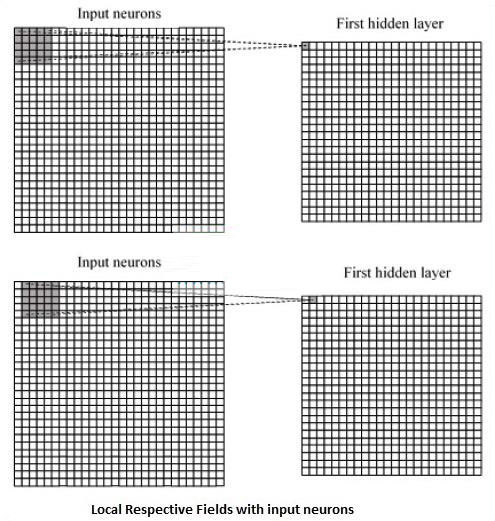在瞭解了機器學習概念之後,現在可以將注意力轉移到深度學習概念上。深度學習是機器學習的一個分支。深度學習實現的示例包括圖像識別和語音識別等應用。
以下是兩種重要的深度神經網路 -
- 卷積神經網路
- 遞歸神經網路
在本章中,我們將重點介紹CNN - 卷積神經網路。
卷積神經網路
卷積神經網路旨在通過多層陣列處理數據。這種類型的神經網路用於圖像識別或面部識別等應用。CNN與其他普通神經網路之間的主要區別在於CNN將輸入視為二維陣列並直接在圖像上操作,而不是專注於其他神經網路所關注的特徵提取。
CNN的主導方法包括識別問題的解決方案。像穀歌和Facebook這樣的頂級公司已經投入研究和開發識別專案,以更快的速度完成。
卷積神經網路使用三個基本思想 -
- 局部感受域
- 卷積
- 池
下麵詳細地來瞭解這些想法。
CNN利用輸入數據中存在的空間相關性。神經網路的每個併發層連接一些輸入神經元。該特定區域稱為局部感受域。局部感受域聚焦於隱藏的神經元。隱藏的神經元處理所提到的字段內的輸入數據,而沒有實現特定邊界之外的變化。
以下是生成局部感受域的圖表表示 -

如果觀察上述表示,可以看到每個連接都學習隱藏神經元的權重,並且具有從一個層到另一個層的移動的相關連接。在這裏,各個神經元不時地進行轉換。這個過程叫做“卷積”。
從輸入層到隱藏特徵映射的連接的映射被定義為“共用權重”,並且包括的偏差被稱為“共用偏差”。
CNN或卷積神經網路使用彙集層,這些層是在CNN聲明之後立即定位的層。它將來自用戶的輸入作為來自卷積網路的特徵映射並準備精簡的特徵映射。池層有助於創建具有先前層的神經元的層。
CNN的TensorFlow實現
在本節中,我們將瞭解CNN的TensorFlow實現。需要執行整個網路的適當尺寸的步驟如下所示 -
第1步 - 包括計算CNN模型所需的TensorFlow和數據集模組所需的模組。
import tensorflow as tf
import numpy as np
from tensorflow.examples.tutorials.mnist import input_data
第2步 - 聲明一個名為run_cnn()的函數,該函數包含各種參數和優化變數以及數據占位符的聲明。這些優化變數將聲明訓練模式。
def run_cnn():
mnist = input_data.read_data_sets("MNIST_data/", one_hot = True)
learning_rate = 0.0001
epochs = 10
batch_size = 50
第3步 - 在此步驟中,我們將使用輸入參數聲明訓練數據占位符 - 對於28 x 28像素= 784。它是從mnist.train.nextbatch()中提取的展平圖像數據。
我們可以根據要求重塑張量。第一個值(-1)告訴函數根據傳遞給它的數據量動態調整該維度。將兩個中間尺寸設置為圖像尺寸(即28×28)。
x = tf.placeholder(tf.float32, [None, 784])
x_shaped = tf.reshape(x, [-1, 28, 28, 1])
y = tf.placeholder(tf.float32, [None, 10])
第4步 - 現在創建一些卷積層 -
layer1 = create_new_conv_layer(x_shaped, 1, 32, [5, 5], [2, 2], name = 'layer1')
layer2 = create_new_conv_layer(layer1, 32, 64, [5, 5], [2, 2], name = 'layer2')
第5步 - 將輸出平坦化為完全連接的輸出階段 - 在兩層尺寸為28 x 28的步幅2彙集後,尺寸為14 x 14或最小7 x 7 x,y座標,但是有64個輸出通道。要創建與“密集”層完全連接,新形狀需要為[-1,7 x 7 x 64]。可以為此圖層設置一些權重和偏差值,然後使用ReLU啟動。
flattened = tf.reshape(layer2, [-1, 7 * 7 * 64])
wd1 = tf.Variable(tf.truncated_normal([7 * 7 * 64, 1000], stddev = 0.03), name = 'wd1')
bd1 = tf.Variable(tf.truncated_normal([1000], stddev = 0.01), name = 'bd1')
dense_layer1 = tf.matmul(flattened, wd1) + bd1
dense_layer1 = tf.nn.relu(dense_layer1)
第6步 - 具有特定softmax啟動的另一層與所需的優化器定義精度評估,這使得初始化操作符的設置成為可能。
wd2 = tf.Variable(tf.truncated_normal([1000, 10], stddev = 0.03), name = 'wd2')
bd2 = tf.Variable(tf.truncated_normal([10], stddev = 0.01), name = 'bd2')
dense_layer2 = tf.matmul(dense_layer1, wd2) + bd2
y_ = tf.nn.softmax(dense_layer2)
cross_entropy = tf.reduce_mean(
tf.nn.softmax_cross_entropy_with_logits(logits = dense_layer2, labels = y))
optimiser = tf.train.AdamOptimizer(learning_rate = learning_rate).minimize(cross_entropy)
correct_prediction = tf.equal(tf.argmax(y, 1), tf.argmax(y_, 1))
accuracy = tf.reduce_mean(tf.cast(correct_prediction, tf.float32))
init_op = tf.global_variables_initializer()
第7步 - 設置記錄變數,將摘要相加以存儲數據的準確性。
tf.summary.scalar('accuracy', accuracy)
merged = tf.summary.merge_all()
writer = tf.summary.FileWriter('E:\TensorFlowProject')
with tf.Session() as sess:
sess.run(init_op)
total_batch = int(len(mnist.train.labels) / batch_size)
for epoch in range(epochs):
avg_cost = 0
for i in range(total_batch):
batch_x, batch_y = mnist.train.next_batch(batch_size = batch_size)
_, c = sess.run([optimiser, cross_entropy], feed_dict = {
x:batch_x, y: batch_y})
avg_cost += c / total_batch
test_acc = sess.run(accuracy, feed_dict = {x: mnist.test.images, y:
mnist.test.labels})
summary = sess.run(merged, feed_dict = {x: mnist.test.images, y:
mnist.test.labels})
writer.add_summary(summary, epoch)
print("\nTraining complete!")
writer.add_graph(sess.graph)
print(sess.run(accuracy, feed_dict = {x: mnist.test.images, y:
mnist.test.labels}))
def create_new_conv_layer(
input_data, num_input_channels, num_filters,filter_shape, pool_shape, name):
conv_filt_shape = [
filter_shape[0], filter_shape[1], num_input_channels, num_filters]
weights = tf.Variable(
tf.truncated_normal(conv_filt_shape, stddev = 0.03), name = name+'_W')
bias = tf.Variable(tf.truncated_normal([num_filters]), name = name+'_b')
#Out layer defines the output
out_layer =
tf.nn.conv2d(input_data, weights, [1, 1, 1, 1], padding = 'SAME')
out_layer += bias
out_layer = tf.nn.relu(out_layer)
ksize = [1, pool_shape[0], pool_shape[1], 1]
strides = [1, 2, 2, 1]
out_layer = tf.nn.max_pool(
out_layer, ksize = ksize, strides = strides, padding = 'SAME')
return out_layer
if __name__ == "__main__":
run_cnn()
以下是執行上述代碼生成的輸出 -
See @{tf.nn.softmax_cross_entropy_with_logits_v2}.
2019-09-19 17:22:58.802268: I
T:\src\github\tensorflow\tensorflow\core\platform\cpu_feature_guard.cc:140]
Your CPU supports instructions that this TensorFlow binary was not compiled to
use: AVX2
2019-09-19 17:25:41.522845: W
T:\src\github\tensorflow\tensorflow\core\framework\allocator.cc:101] Allocation
of 1003520000 exceeds 10% of system memory.
2019-09-19 17:25:44.630941: W
T:\src\github\tensorflow\tensorflow\core\framework\allocator.cc:101] Allocation
of 501760000 exceeds 10% of system memory.
Epoch: 1 cost = 0.676 test accuracy: 0.940
2019-09-19 17:26:51.987554: W
T:\src\github\tensorflow\tensorflow\core\framework\allocator.cc:101] Allocation
of 1003520000 exceeds 10% of system memory.
